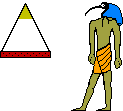
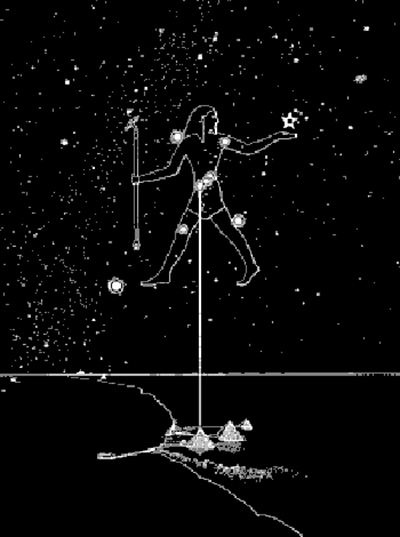


The Great Pyramid was created as a mathematical construct with precise alignments on and off the planet. Some believe that extraterrestrials created the pyramid mathematically encoding it physically and nonphysically to help souls remember that the human experiment is an algorithm set in place to study emotions. It had a beginning and therefore an end which rapidly approaches based on many factors created by Simulation Theory.
In the Age of Artificial Intelligence we have come to understand virtual reality, and that we are part of a simulation. We are in fact, a holographic construct that is reaching its Apex much like the symbolic Pyramidion at the top of the pyramid.
There are many theories about who built the great pyramid, but it was actually set in place by the simulation itself. It could view it as a marker alongside the Sphinx (added later) for whatever their purposes as humanity evolves out of the illusion of time and emotion.
In current times, the alignments on the Giza plateau are part of the study of sacred geometry - the fibonacci sequence upon which reality is based.
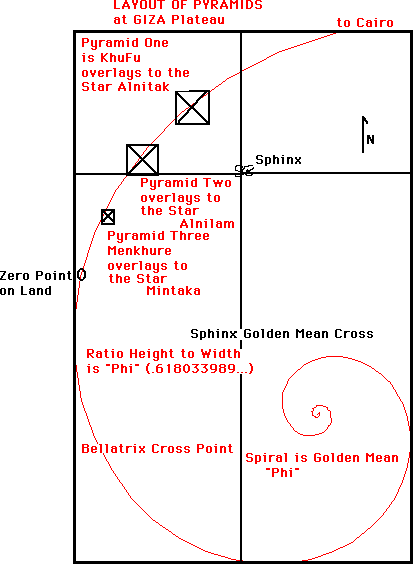
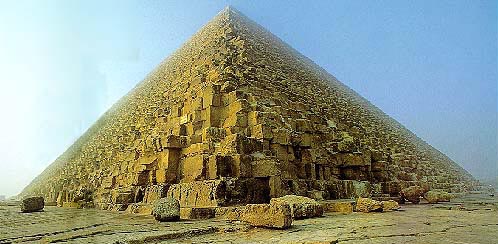
The exact number of stones was orginaly estimated at 2,300,000 stone blocks weighing from 2-30 tons each with some weighing as much as 70 tons. Computer calculations indicate 590,712 stone blocks were used in its construction. It area covers 13.6 acres with each side greater than 5 acres in area.
There are supposedly 144,000 casing stones, all highly polished and flat to an accuracy of 1/100th of an inch, about 100 inches thick and weighing about 15 tons each with nearly perfect right angles for all six sides. Computer calculations indicated 40,745 casing stones were used averaging 40 tons each before the face angle was cut.
The average casing stone on the lowest level was 5 ft. long by 5 ft. high by 6 ft. deep and weighed 15 tons. The casing stones weighing as much as 20 tons were placed with an accuracy of 5/1000ths of an inch, and an intentional gap of about 2/100ths of an inch for mortar.
The casing stones for the Great Pyramid were cut in quarries from Tura and Masara located on the east bank of the Nile on outskirts of Cairo.
The mortar used is of an unknown origin. It has been analyzed and it's chemical composition is known but it can't be reproduced. It is stronger than the stone and still holding up today. The cornerstone foundations of the pyramid have ball and socket construction capable of dealing with heat expansion and earthquakes. The four corner sockets are at different heights. The vertical distance between the highest and lowest is 17 inches. The reference point known as the "mean socket level", or base level, is generally used as the reference for height and perimeter measurements. The "sidereal socket level" is the mean of just the SW and SE socket heights.
The length of a base is 9131 PI from corner to corner in a straight line. The length of a base side at the base socket level is 9131 pyramid inches or 365.24 pyramid cubits. The length of a base side at sidereal socket level is 9131.4 pyramid inches or 365.256+ pyramid cubits. The length of the perimeter at the sidereal socket level is 36525.63629+ pyramid inches. 201 complete courses of masonry remain with remnants of 2 more at the summit.
The top surface is 5478 pyramid inches above the mean socket level. Another 335 pyramid inches higher is the geometric apex formed by the corner edges of the projected mantle. The 35th course of stones is roughly 50 inches tall, nearly twice the height of the previous courses. The height of the 35th course = 1162.6 PI from ground or the length of the Antechamber x 10.
The capstone is thought to have been intact about 100 B.C. since no mention of its absence was recorded by the historian Diodorus Siculus. The capstone of the pyramid is thought to have always been absent.
The capstone is thought to have been an exact replica of the large pyramid on a scale of 1 to sqrt(Pi)/100. The ratio of any corresponding pyramid dimension over the capstone dimension, when multiplied by the square root of Piequals 100. The estimated height of the capstone is about 103.03+ pyramid inches and about 6-1/2 cubits on a side.
The height of the pyramid to the missing apex formed by extending the sides is 5813 PI. The perfect formula height of the pyramid including the missing apex is 5813.2355653763+ PI, calculated from perimeter of base (sidereal s ocket level) divided by 2 Pi.
The height to the missing apex is 5812.98 PI.
The height of the pyramid without the capstone is 5496 PI.
The four faces of the pyramid are slightly concave, the only pyramid to have been built this way.
The centers of the four sides are indented with an extraordinary degree of precision forming the only 8 sided pyramid. The effect is not visible from the ground or from a distance but only from the air, and then only under the proper lighting conditions.
The 5 angles of the Great Pyramid are:
edge to edge of face at apex =76:17:13.2 (degrees - minutues - seconds),
edge to diagonal edge at apex = 96:3:0.0, dihedral or
face to face parallel to base = 112:25:39.4
edge to base = 41:59:50.5
face to base = 51:51:14.3.
The face to base angle is the angle of the casing stones.
The Great Pyramid is the only pyramid to have chambers above ground level.
The volume of the pyramid is:
V = 1/3 base area x height =161,559,817,000 cubic
PI = 10,339,828.3 cubic pyramid cubits
{(5813.2355653 PI)/3 * 9131 PI * 9131 PI}
The length of the Great Pyramid's corner edges are 8688.00 PI.
The slant face height of the Great Pyramid's sides are 7391.72 PI.
The area of the base covers 13.3 acres or 83,375,161 sq. PI.
The area of each face covers 10.8 acres or 67,493,782 sq PI.
The angle of the Descending Passage is 26 deg, 18 min, 9.5 sec or about 26.30 degrees.
The passages are straight to within 0.013 in. per 100 ft.
The dimensions of the Descending Passage are 4535 PI in length, 41.524 PI in
width, and 36.197 PI in height. [4:197]
The length of the Ascending passage from the junction of the Descending Passage to the Grand Gallery is 1543.46451 PI.
The Great Pyramid had a swivel door entrance at one time.
Swivel doors were found in only two other pyramids:
Khufu's father and grandfather, Sneferu and Huni, respectively.
It is reported that when the pyramid was first broken into that the swivel door, weighing some 20 tons, was so well balanced that it could be opened by pushing out from the inside with only minimal force, but when closed, was so perfect a fit that it could scarcely be detected and there was not enough crack or crevice around the edges to gain a grasp from the outside.
The original entrance was located on the north face, about 49 feet above the base and 24 feet east of the central axis of the north face.

Gantenbrink's Door
Of all the pyramids, only the Great Pyramid has "air shafts".
The King's Chamber has 2, about 5 inches in diameter which connect to the exterior.
The Queen's Chamber has 2 which stopped just short of the walls of the chamber and which do not penetrate completely to the exterior.
The cross section of these shafts are sometimes oval, sometimes domed, and sometimes rectangular.
There are no hieroglyphics or writings in the Great Pyramid other than those written later but not the pyramid builders. They are found in an upper relief chamber - some graphics on the wall of the Room of Chaos.
Each of the ceiling stones in the Grand Gallery were individually removable.
The Great Pyramid could have functioned as a stellar observatory during its construction.
There are 36 ceiling stones in the roof of the Grand Gallery.
Taking average earth density as 1.0, the average density of the core limestone blocks is 0.412, the limestone casing blocks is 0.367, the granite of the King's Chamber is 0.479.
The estimate for the average density of the pyramid as a whole, taking into account the different type and quantities of stone as well as the hollow chambers is 0.4078994+ times that of the average earth density (taken as 1.0)
Sixty-five meters up the southern shaft of the Queen's Chamber is a miniature portcullis slab discovered by a robotic camera in 1993. Attached are two copper fittings, one broken. This area of the shaft is lined with Tura limestone, which is typically used in pyramids only for lining chambers.
In the King's Chamber all of the stone joints are very tight except in the lower eft-hand corner of the west wall. Here the joints are larger than normal and covered by mortar. This is a strong indication of an opening to another chamber or passage. The Egyptian government has refused requests for further exploration.
In 1986 a French team using microgravimeter equipment detected small hidden cavities behind the west wall of the horizontal passage to the Queen's Chamber. They were permitted to bore a 1" diameter hole and found a cavity filled with sand. They were not permitted to dig or tunnel for further investigation.
The cavities in the horizontal passage to the Queen's Chamber correspond to two floor stones in this passageway with joints perpendicular to the rest of the joints in the floor stones. This type of indicator can also be found at the junction of the descending and ascending passageways.
About 70 feet along the north side of the Great Pyramid from the northeast corner is a 4x10 ft stone sunk into the foundation at an angle. The joints are very precise and this is the only stone in the foundation perimeter not at a right angle to normal construction. It would have been covered by the mantle but is now accessible since the mantle is gone. It is very likely an entrance. No further investigation has been done.
It has long been believed that the Sphinx had subterranean tunnels leading to each of the three major pyramids. In October, 1994, a passage leading to a subterranean area beneath the Sphinx was re-discovered.
In 1987 a Japanese team used an electromagnetic wave method to search for cavities in the Great Pyramid. They identified a cavity under the horizontal passage to the Queen's Chamber about 1.5 meters beneath andextending for 2.5-3.0 meters in depth. They also identified a cavity behind the western part of the northern wall of the Queen's Chamber. They identified nocavities within the King's chamber, possibly due to the denser granite walls. Three potential cavities were identified in the area of the Sphinx.
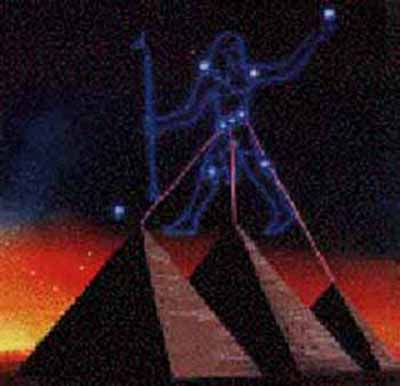
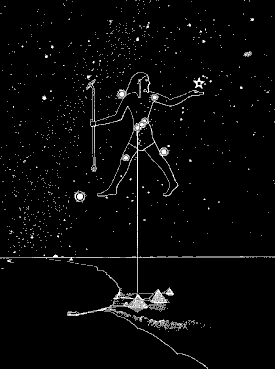
The three main pyramids line up with
the Belt of Orion.
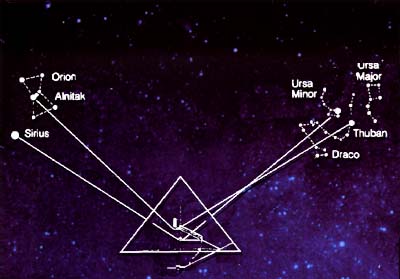
This alignment is in accordance with Duat, the art of placement as it was practiced in ancient Egypt, wherein the structures of the earth are positioned to mirror the architecture of heaven.
The information encoded into the Great Pyramid is repeated multiple times. With the mantle in place, the Great Pyramid could be seen from the mountains in Israel and probably the moon as well. Its polished surfaces would have reflected light like a beacon.
Mean Earth Temperature:
The average temperature of Egypt equals the average temperature of earth = avg. temperature of Queen's Chamber = 68 degrees Fahrenheit. With the original surrounding courtyards and temples in place, the pyramid was used as a sundial.
The pyramid was used to indicate solstices and equinoxes.
The pyramid is located at 29 degrees, 58 minutes, 51.06 seconds north latitude, and 31 degrees, 9 minutes, and 0.0 seconds east longitude.
Marks Spring Equinox:
Due to the angle of the sides of the pyramid vs. its latitude, it casts no shadow at noon during the spring equinox.
Aligned True North:
The Great Pyramid is the most accurately aligned structure in existence and faces true north with only 3/60th of a degree of error. The position of the North Pole moves over time and the pyramid was probably exactly aligned at one time.
Center of Land Mass:
The Great Pyramid is located at the center of the land mass of the earth. The east/west parallel that crosses the most land and the north/south meridian that crosses the most land intersect in two places on the earth, one in the ocean and the other at the Great Pyramid.
Tropical Year or Calendar Year:
The length of a base side is 9131 pyramid inches measured at the mean socket level, or 365.24 pyramid cubits, which is the number of days in a year. {9131/25 = 365.24, accurate to 5 digits}
Tropical Year:
The perimeter of the base divided by 100 = 365.24, the number of days in a year. {9131 PI * 4 / 100, accurate to 5 digits}
Tropical Year:
The length of the Antechamber used as the diameter of a circle produces a circumference of 365.242. {accurate to 6 digits}
Tropical Year:
The length of the granite portion of the floor of the antechamber to the King's Chamber times 2*sqrt(Pi) = 365.242
Tropical Year:
The ratio of the lengths of the Grand Gallery to the solid diagonal of the King's Chamber times 100 equals the number of days in a tropical year. {(1881.5985600 / 51.516461) * 100 = 365.242200, accurate to 8 digits}
Mean Distance to the Sun:
The height of the pyramid times 10**9 = avg. distance to sun. {5813.2355653 * 10**9 * (1 mi / 63291.58 PI) = 91,848,500 mi} Mean Distance to the Sun: Half of the length of the diagonal of the base times 10**6 = average distance to the sun Mean Distance to Sun: The height of the pyramid times 10**9 represents the mean radius of the earth's orbit around the sun, or Astronomical Unit. { 5813.235565376 pyramid inches x 10**9 = 91,848,816.9 miles} Mean Distance to Moon: ] The length of the Jubilee passage times 7 times 10**7 is the mean distance to the moon. {215.973053 PI * 7 * 10**7 =1.5118e10 PI = 238,865 miles }
Sun's Radius:
Twice the perimeter of the bottom of the granite coffer times 10**8 is the sun's mean radius. { 270.45378502 PI* 10**8 = 427,316 miles}
Earth's Polar Radius:
The sacred cubit times 10**7 = polar radius of the earth (distance from North Pole to Earth's center) {25 PI * 10**7 * (1.001081 in / 1 PI) * (1 ft / 12 in) * (1 mi/ 5280 ft) = 3950 miles }
Radius of the Earth:
The curvature designed into the faces of the pyramid exactly matches the radius of the earth.
The sum of the pyramid's twobase diagonals in PI = length of the Precession of the Equinoxes (~25827 years) Precession of the Equinoxes:
The distance from the ceiling of the King's Chamber to the apex of the pyramid = 4110.5 PI. Which is the radius of a circle whose circumference = the precession of the equinoxes. {4110.5 * 2 * Pi= 25827}
The perimeter of the 35th course of blocks, which is much thicker than any of the other courses, gives a figure for the precession of the equinoxes. Average Land Height:
The average height of land above sea level for the earth is 5449 inches. This is also the height of the pyramid.
The pyramid suggests a temperature system: 0 = freezing point of water, 50 = unvarying temp of Queen's Chamber, 250 = boiling point of water.
Given this, then 1000 = temp of red hot iron, 4000 = temp that iron liquifies, and 5000 = temp of white heat and temp that platinum fuses. Nice round numbers. [39:45] - 5 cubic pyramid inches of earth of average density has the same mass as 1/(50x50) of the coffer's volume of water at a temperature that is 1/5th the difference between freezing and boiling.
On midnight of the autumnal equinox in the year of the Great Pyramid's completion, a line extending from the apex pointed to the star Alcyone.
Our solar system is thought by some to revolve around this star along with other solar systems much like the planets revolve around our sun.
A line drawn on a map from the apex of the pyramid to Bethlehem =angle of the Ascending Passage and crosses the Red Sea at the most likely point that the Israelites crossed when departing Egypt (Parting of the Red Sea).
A line drawn on a map south from the apex of the pyramid at the angle of the Ascending Passage crosses Mount Sinai (Ten Commandments).
North Star Pointer:
The Descending Passage pointed to the pole star Alpha Draconis, circa 2170-2144 B.C. This was the North Star at that point in time. No other star has aligned with the passage since then.
The 344 ft. length of the Descending Passage provides an angle of view of only +/- 1/3 of a degree. Alpha Draconis has not been in alignment for thousands of years. The next alignment will be with the North Star, Polaris, in about 2004 A.D.
The southern shaft in the King's Chamber (45 deg, 00 min, 00 sec) pointed to the star Al Nitak (Zeta Orionis) in the constellation Orion, circa 2450 B.C.
The Orion constellation was associated with the Egyptian god Osiris.
No other star aligned with this shaft during that Epoch.
The northern shaft in the King's Chamber (32 deg, 28 min, 00 sec) pointed to the star Alpha Draconis, circa 2450 B.C.
The southern shaft in the Queen's Chamber (39 deg, 30 min, 00 sec) pointed to the star Sirius, circa 2450 B.C. Sirius was associated with the Egyptian goddess Isis and is also part of a unique ceremony practiced by the African Dogon tribe.
The northern shaft in the Queen's Chamber (39 deg, 00 min, 00 sec) pointed to the star Ursa Minor, circa 2450 B.C.
Five of the 7 brightest stars have pyramid equivalents: The 3 great pyramids of Khufu, Khafra, and Menkaura for the belt of Orion, the pyramid of Nebka at Abu Rawash corresponds to the star Saiph, the pyramid at Zawat al Aryan corresponds to the star Bellatrix. The only two missing star positions are for Betelgeuse and Rigel.
Of the three pyramids, Cheops is the most significant because it contains a portal. In a fictionalized account of this, the movie Stargate, the portal links from the pyramid to some far planet.
[Stargate - TV series Stargate SG1 - SG - Sacred Geometry of our consciousness program.]
The interior temperature at 62 degree Fahrenheit.
The pyramid is the only remaining structure of the 7 wonders of the ancient world.
The polished surfaces of the original mantle reflected heat, sunlight, and moonlight and was probably used as to aid Nile river navigation at night.
No mummy has ever been found in a pyramid in Egypt. Mummies have always come from mastabas or tombs in the Valley of the Kings.
The word Pharaoh is from the Hebrew interpretation of the Egyptian per aa, originally meaning the great house.
The word pyramid is composed of the Greek words pyra meaning fire, light, or visible, and the word midos meaning measures.
Between 1300-1700 A.D. mummy flesh was ground into powder and used in Europe as medicinal aids. Mummy powder has also been used for artist paints.
Mummy wrappings were at one time used to make paper and burned in fireplaces by poor Egyptians.
The pyramids of Giza are among the oldest man-made structures in existence.
Cleopatra was the last pharaonic ruler of Egypt before it fell to Rome in 30 B.C.
Initially, after the 5 chambers above the King's Chamber were opened, those that entered the 2nd chamber were turned black by a powder which existed only in that chamber. It was analyzed and determined to be the dust from the cast off shells and skins of insects.
Most pyramids were accompanied by smaller satellite pyramids usually built to the south and east of the main pyramid. Some were tombs for queens and princesses. Most of the structures were mastabas built to entomb the pharaoh's family, members of royalty, and the priestly class. In nearly all of the pyramids and tombs, it was a general practice that the burial chamber was oriented slightly west of the north/south center line of the pyramid.
In ancient Egypt, Pharaoh's wives were never buried with them in pyramids or tombs, they were buried separately.
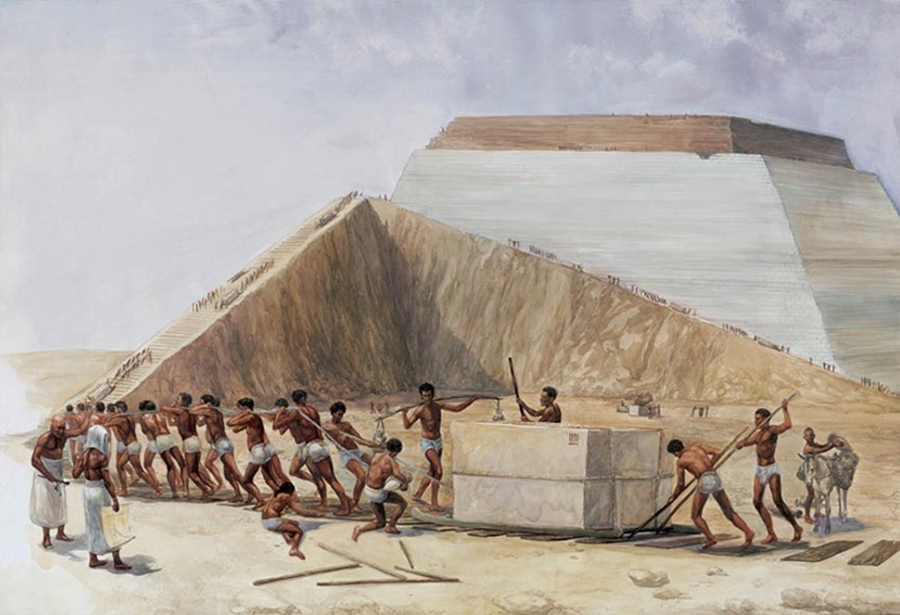
Building The Pyramids